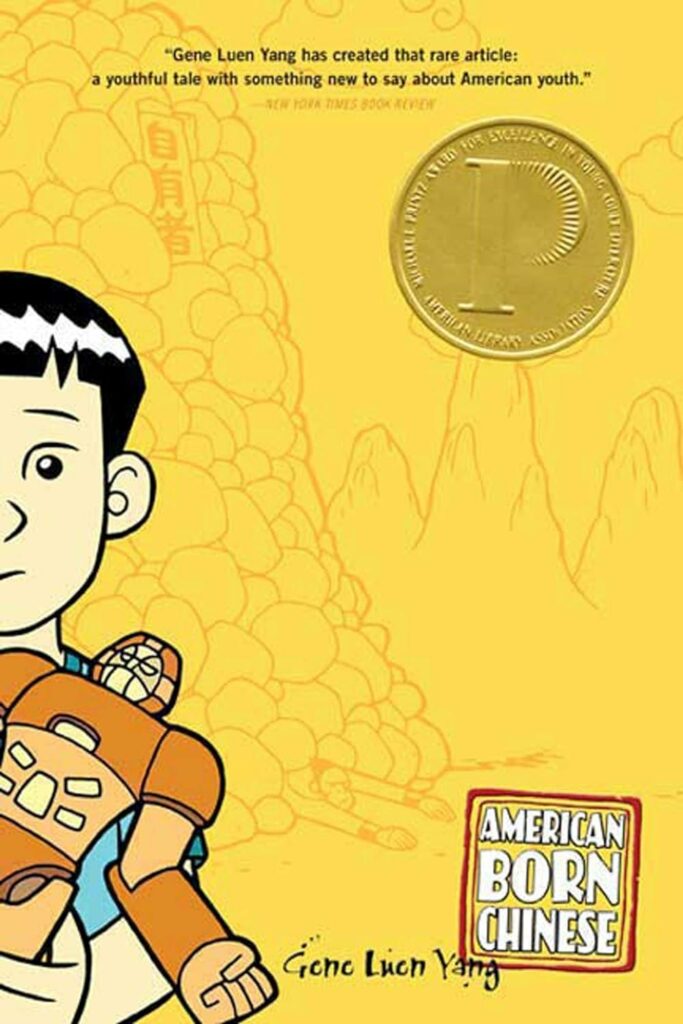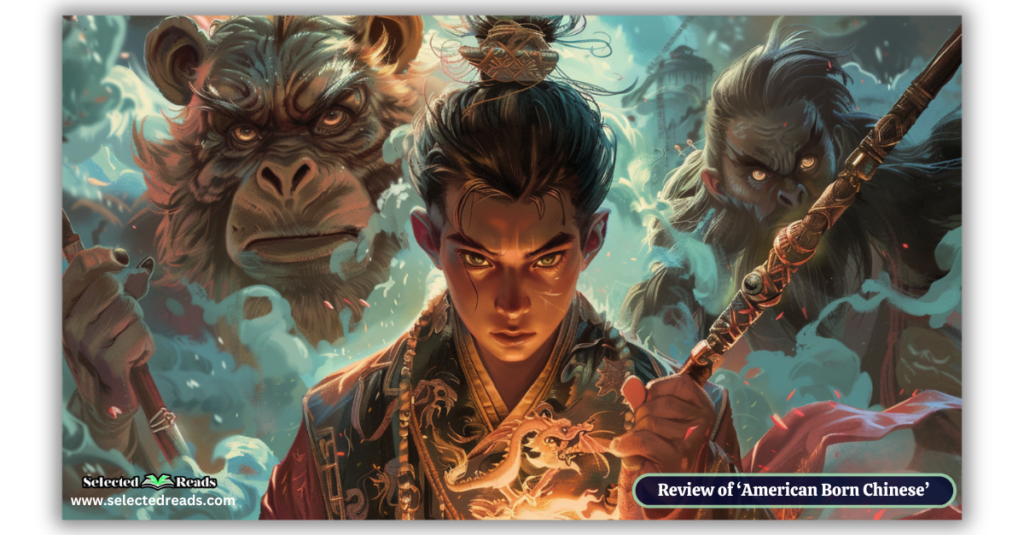For fans of graphic novels that explore profound themes of identity and culture, “American Born Chinese” by Gene Luen Yang is a treasure trove of narrative depth and visual artistry. This post is designed to guide you through the intricate layers of this award-winning novel without giving away its compelling twists and turns.
Here’s how we’ll unfold our exploration: We’ll start with a concise summary of the story to set the stage. Following that, we’ll delve into the rich tapestry of characters that bring the story to life. To conclude, I’ll provide a series of engaging discussion questions that are perfect for sparking deep conversations in book clubs or classroom settings.
American Born Chinese Summary
“American Born Chinese” by Gene Luen Yang is a captivating graphic novel that weaves together the stories of three distinct characters, each exploring different facets of cultural identity, myth, and personal acceptance. The narrative cleverly interlinks the lives of these characters in a manner that addresses the complexities of race and ethnicity, ultimately converging in an unexpected and enlightening climax.
The first narrative thread follows Jin Wang, a young Chinese-American who struggles with his identity after moving to a new neighborhood where he is the only Chinese-American student in his school. Jin’s experiences are marked by feelings of isolation and a desire to fit in. He faces both overt racism and subtle cultural disconnects, grappling with his self-image and attempting to navigate a space where he can be accepted for who he is.
Photo: Amazon
The second storyline is a retelling of the legendary tale of the Monkey King, a classic figure in Chinese folklore. This powerful and proud character refuses to be seen as lesser by the celestial community because of his origins. After being denied entry to a party in heaven because he is a monkey, the Monkey King embarks on a journey of self-improvement, mastering skills and powers that he believes will force others to respect him. Despite his mighty efforts and prowess, he encounters further rejection and hostility, leading to a fateful confrontation that results in his imprisonment under a mountain.
The third character, Chin-Kee, represents the embodiment of all the negative stereotypes of Chinese culture. He visits his cousin Danny yearly, each visit proving disastrous to Danny’s social life due to Chin-Kee’s exaggerated and offensive behavior. Danny’s storyline explores the impact of stereotypes on personal identity and the extreme lengths one might go to in order to escape them.
As the novel progresses, these three story arcs converge in a manner that challenges each character’s understanding of themselves and their culture. Jin Wang learns to embrace his heritage rather than seeing it as a barrier to acceptance. The Monkey King’s tale intersects with Jin’s life, revealing themes of humility and true strength. Meanwhile, the story of Chin-Kee and Danny serves as a poignant commentary on the internalization of racial stereotypes and the desire to conform to mainstream norms.
The culmination of these intertwined stories offers a powerful message on the acceptance of oneself and the rejection of the pressures to assimilate into a singular cultural identity. Through its inventive narrative structure and expressive artwork, “American Born Chinese” not only entertains but also imparts significant reflections on identity, society, and acceptance, making it a meaningful read across various age groups and cultural backgrounds.
Related: The Hate U Give Summary and Characters
American Born Chinese Characters
“American Born Chinese” by Gene Luen Yang features three central characters, each exploring themes of identity and acceptance through their unique narratives. Here’s a closer look at each:
- Jin Wang: Jin is a Chinese-American boy who is the main protagonist in one of the interwoven stories. He moves to a new area and attends a school where he is the only Chinese-American student, which isolates him from his peers. Jin’s journey is one of self-discovery and acceptance, grappling with the challenges of adolescence, cultural identity, and the desire to fit into American society. He struggles with issues of racism and stereotypes, which profoundly affect his self-esteem and social interactions.
- The Monkey King: A classic figure from Chinese folklore, the Monkey King, or Sun Wukong, is portrayed as a powerful and skilled martial artist who is not accepted by the gods because he is a monkey. His storyline in the novel explores themes of pride, power, and transformation. The Monkey King’s quest for acceptance and recognition leads him through various trials and tribulations, ultimately teaching him lessons about humility and the true meaning of greatness.
- Chin-Kee: Chin-Kee represents the amalgamation of negative Chinese stereotypes and serves as a disruptive force in the life of his cousin, Danny. His character is exaggerated and offensive, embodying all the worst stereotypes of Chinese people as seen through the lens of American culture. Chin-Kee’s annual visits ruin Danny’s social life, causing extreme embarrassment and distress. His character challenges the reader to confront uncomfortable stereotypes and the impact they have on individuals and their identities.
American Born Chinese Discussion Questions
Here are some thought-provoking discussion questions that can help delve deeper into the themes and narratives of the book:
- Identity and Assimilation: How does Jin Wang’s struggle with his identity reflect the experiences of many first-generation immigrants? Discuss how Jin’s desire to fit in conflicts with maintaining his cultural heritage.
- Stereotypes and Perception: Chin-Kee is a character that embodies extreme stereotypes. What role do you think Chin-Kee plays in the overall message of the book? How does his character affect your understanding of how stereotypes work in society?
- Mythology and Modernity: The Monkey King is a character taken from ancient Chinese mythology. How does his story parallel the modern-day experiences of Jin and Danny? What does his journey say about the nature of pride and redemption?
- Intersection of Stories: The novel’s structure interweaves three seemingly separate stories. At what point did you realize how these stories were connected? How does the structure affect the way you understand the book’s themes?
- Cultural Identity vs. Personal Identity: Discuss how the characters in the book navigate their cultural identity versus their personal identity. How do these identities conflict and coalesce throughout the narrative?
- Impact of Culture on Personal Growth: How does each character’s cultural background influence their decisions and growth throughout the story? Consider Jin, the Monkey King, and Danny in your answer.
- The Role of Humor: Despite its serious themes, the book incorporates a significant amount of humor. How does humor contribute to the book’s message? Does it enhance or detract from the serious issues discussed?
- Lessons Learned: What are the main lessons that each character learns by the end of the book? How do these lessons relate to real-world issues facing readers?
- Symbolism in the Book: Discuss the symbolism of transformation and shape-shifting in the novel. What do these elements symbolize in terms of identity and self-acceptance?
- Recommendations for Change: Based on the challenges faced by the characters, what changes would you recommend for individuals or society to better handle cultural diversity and integration?
Related: Patron Saints of Nothing Summary and Characters
Final thoughts
To conclude, I trust this brief exploration into “American Born Chinese” has piqued your interest. This graphic novel is a masterful blend of humor, mythology, and poignant commentary on identity and culture. If you haven’t yet experienced this compelling narrative, I highly recommend picking up a copy. It’s a journey that promises not only to entertain but also to challenge and enrich your understanding of cultural diversity.









